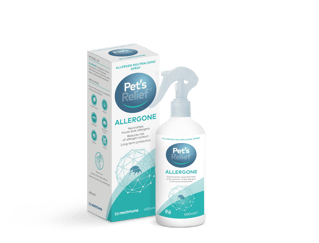.jpeg?width=726&height=667&name=shutterstock_1756838960%20(1).jpeg)
Allergen Avoidance for Companion Animals
For many pets, allergens are a primary cause of discomfort, leading to conditions like atopic dermatitis. While the ideal solution would be to eliminate these triggers, total allergen avoidance is impossible. Allergens are present in many everyday environments, and even with the best efforts, pets will inevitably encounter some form of exposure.
While we cannot eliminate all allergens, there are several strategies that can help to reduce contact and potentially the severity of allergic reactions.
Tips to reduce exposure to house dust mites
- Pets should be kept outside bedrooms, as mites love mattresses and bedding.
- Mite-proof pet beds and covers.
- Bedding and stuffed toys should be washed weekly in 60 °C hot water
- Minimize use of carpets, upholstered furniture and other household fabrics, such as curtains. Smooth floors and blinds can be cleaned easily.
- Air filters for the furnace and air conditioning should be changed regularly or replaced for allergen-control filters.
- Regular grooming and bathing to remove mite droppings from the pet’s fur and skin.
- Regular dust and vacuum using double layer micro flirtation dust bags.
- Humidity of less than 45% with help of a dehumidifier.
- Room temperature of 21°C or less.
- Allergen neutralizing sprays for the house environment: Pet’s Relief Allergone is an innovative spray designed to reduce the exposure to house dust allergens. It provides long term protection of 5 months after a single application.
Pet’s Relief Allergone
...is an innovative allergen-neutralising spray designed to reduce the exposure to house-dust allergens. It provides long-term protection of up to 5 months after a single application.
It can neutralise house dust-mite allergens because of its core of microcapsules filled with a mixture of substances that alter the chemical structure of allergens particles.

It reduces the exposure to dust allergens by forming a polymer film that glues dust particles together to form larger particles, thus stopping them from floating in the air. The aggregated particles can then be removed easily by conventional cleaning.
-
.jpg)
House dust mites are really common and are present in pretty much every home. Their waste is one of the most common allergens to pets.
Tips to reduce exposure to storage dust mites
- Airtight containers to keep food tightly closed and stored in a cool, dark and dry environment.
- Food packages should be thrown away immediately and not kept in a bin indoors.
- Food stockpiles should be reduced by buying smaller amounts. Maximum storage time should be less than one month.
- Pet food and treats should be stored in the freezer until needed.
- Sites where food is consumed should be vacuumed regularly and double layer micro filtration dust bags should be used.
- Pet’s face should be wiped with a damp cloth after they finish eating to remove food remains.
- Food bowls should be cleaned evert day with detergent and hot water.
- Relative humidity of less than 45% with the help of dehumidifier.
- Room temperature of 21 °C or less.
- Regular grooming and bathing to remove mite droppings from the pet’s fur and skin.
- Furnace filters changed regularly.
Tips to reduce exposure to pollens
- Important to start by identifying which pollens are responsible for symptoms via allergy testing so they can be removed from animal environment if present in backyard, house or to identify main pollen months.
- Windows should be kept closed as much as possible on windy and dry days. Best to open windows when pollen count is low: after rainfall, in the morning or in the evening.
- Pet should stay indoors when local areas are being mowed.
- Car and air-conditioning filters should be changed regularly or replaced with allergen-control filters.
- Regular dust and vacuum using double layer micro flirtation dust bags.
- Important to follow pollen forecasts.
- Clothes and bedding should be dried indoors instead of being placed outdoors.
- Regular grooming and bathing to remove pollens from the pet’s fur and skin.
Tips to reduce exposure to molds
- Molds should be removed from damp environments and surfaces with a mold cleaner.
- Low humidity and increased ventilation indoors.
- Indoor plants should be checked for molds.
- Forest walks in autumn or in humid weather should be avoided.
- Clothes and bedding should be dried indoors instead of being placed outdoors.
- Room temperature of 21 °C or less.
- Car, furnace and air-conditioning filters should be changed regularly.
- Regular grooming and bathing to remove spores from the pet’s fur and skin.